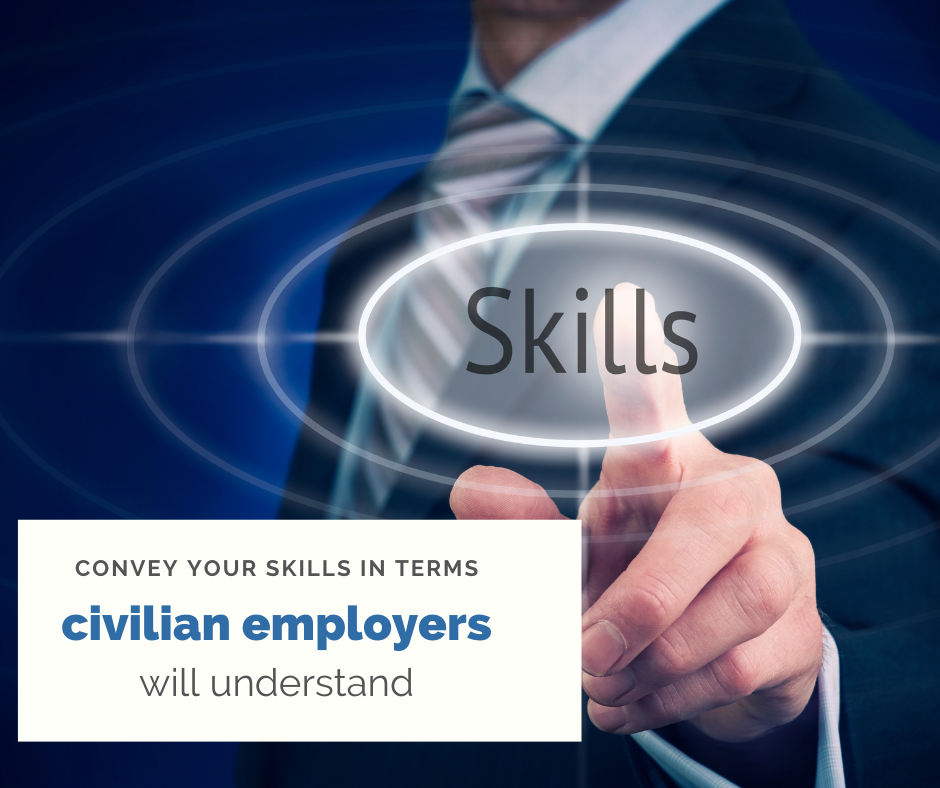 How do you accurately and honestly portray your military skills and experience into language which civilian hiring managers will understand? This is a difficult hurdle for military job seekers to overcome in their civilian job search. It is the job seeker’s responsibility to convey their qualifications in terms that prospective employers will understand. The challenge is to restate military-unique terminology and acronyms in a more industry-relevant way without losing the meaning or impact of your experience.
How do you accurately and honestly portray your military skills and experience into language which civilian hiring managers will understand? This is a difficult hurdle for military job seekers to overcome in their civilian job search. It is the job seeker’s responsibility to convey their qualifications in terms that prospective employers will understand. The challenge is to restate military-unique terminology and acronyms in a more industry-relevant way without losing the meaning or impact of your experience.
STEP 1: RESEARCH & IDENTIFY THE CIVILIAN SKILLS
The process starts with researching civilian occupations to understand the language and skills relevant to your future civilian career field. Use military skills translators, such as www.military.com/veteran-jobs/skills-translator or www.onetonline.org/crosswalk/MOC, to help you identify civilian jobs that are similar to your military occupation and that would require the same or similar skills as your previous job in the military.
Take note of the skills, training, and experience required to perform these jobs. Use sites such as the Department of Labor’s Occupational Outlook Handbook www.bls.gov/ooh or the O*NET Online Crosswalk site http://www.onetonline.org/crosswalk to gain insight into the education, training, or work experience required for civilian jobs.
Conduct informational interviews with friends, colleagues, or acquaintances who are currently employed in the civilian occupation you are interested in. See if they will spend some time talking with you about the nature of their responsibilities. Your focus for these interviews should be on learning what it takes to be successful at the type of job they hold. Most people, especially those with former military experience, will be helpful and offer you a wealth of information.
Use LinkedIn to research your career field and its skill requirements. Search for jobs using the advanced search filters, and take note of what experience and skill requirements are listed on the job postings. Also search for people on Linkedin who have the same type of job you’re hoping to land. Study their profiles to see what education, certification, training, and skills they possess. This will give you a good indication of what is required for that position.
From this research, make a list of the required skills, knowledge, and experience that hiring managers seek. Once you have created the list of your targeted civilian occupations and skills, you can begin the process of matching your military skills and experience with the equivalent or similar civilian skills.
STEP 2: LIST YOUR MILITARY SKILLS & ACCOMPLISHMENTS
Write down your military assignments in reverse chronological order. Use the downloadable worksheet, Work-Content Skills List, from the Corporate Gray Online Transition Guide to describe each assignment in detail. For each skill, describe how you applied the skill (Activities Performed) to accomplish a given task or project (Accomplishments). Where possible, accentuate the content-specific (as opposed to transferrable) skills or knowledge you applied in the performance of your military duties.
At this point, do not worry about the use of military terms or acronyms. Use your Verification of Military Experience and Training (VMET, DD Form 2586) to help create the list, as well as your evaluation reports, training certificates, awards, transcripts, etc.
STEP 3: MAKE A COMPARISON
On a new page, list your military skills from Step 2 in the left column and the needed civilian skills from Step 1 in the right column. Now compare the items on these two lists. Can you connect any of the items on the left to those on the right? If not, is it a problem of semantics (different words but similar meanings) or is it the case that you simply do not currently have the skills required? If the latter, you might consider obtaining additional training or schooling either on a part or full time basis (be sure to use the education benefits you may have earned from your military service).
STEP 4: REVISE YOUR SKILLS TO THE CIVILIAN WORDING
Once you have matched the skills in each column, return to the list of detailed military experience you created in Step 2. For those military skills that relate to your targeted civilian occupations, carefully revise your documented skills and experience by incorporating the appropriate civilian language that relates to what you did in the military. Remember your objective: to accurately and honestly restate your military experience using language that a civilian hiring manager will understand. Replace the military-unique expressions and acronyms with more industry-relevant terms without losing the meaning or impact of your experience.
STEP 5: OBTAIN FEEDBACK
Show this revised write-up to civilian friends and colleagues who are currently working in your employment field(s) of interest. Ask them to objectively critique and evaluate whether it conveys your qualifications in terms relevant to their industry.
STEP 6:
Refine this document by incorporating the comments received in the previous step. The finished document should clearly and accurately portray your qualifications in terms appropriate to the industry in which you desire employment. This document is the Work History of your resume.
Check out these other helpful articles for your transition and job search:
5 Ways to Successfully Showcase Your Military Skills in a Resume
LinkedIn: Building an Effective Profile
Top 10 Free Military Transition Resources

Pingback: How to Align Your Resume with the Job Description | Corporate Gray Blog
Pingback: Common Key Skills and Action Verbs for Military-to-Civilian Resume | Corporate Gray Blog